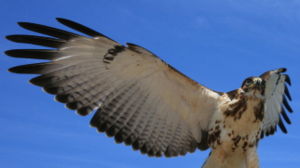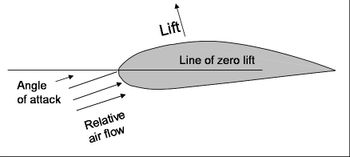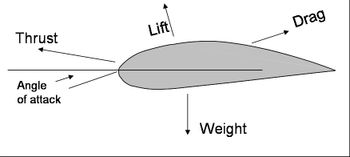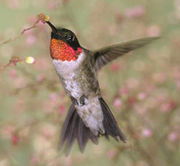Flight is the mode of
locomotion used by most of the world’s
bird
species. It is important to
birds for feeding, breeding and avoiding predators.

An
African Hawk Eagle in flight.
Evolution and purpose of bird
flight
The origin of bird flight is still somewhat unclear, even
though most paleontologists agree that birds evolved from
small theropod dinosaurs. It seems likely that they evolved from ground
living species, with flight developing after the evolution
of
feathers. It seems likely in this case that flight
evolved as a result of benefits in the pursuit of small
airborne prey items (such as
insects), possibly subsequently becoming useful as a
predator avoiding behavior.
Flight is more energetically expensive in larger birds,
and many of the largest species fly by soaring (gliding
without flapping their wings) most of the time. Many
physiological adaptations have evolved that make flight more efficient.
Today birds use flight for many purposes. It is still
used by some species to obtain prey on the wing, as well as
foraging, to commute to feeding grounds, and
migrate between the seasons. Flight's importance in
avoiding predators can be shown in the frequency with which
it is lost when birds reach isolated
oceanic islands that lack ground-based predators. It is
also used by some species to display during the breeding
season and to reach safe isolated places for nesting.
Basic mechanics of bird flight

The lift force has both a forward and a vertical
component
The fundamentals of bird flight are similar to those of
aircraft. Lift force is produced by the action of air-flow
on the wing, which is an airfoil/aerofoil. The lift-force is
because the air has a lower air pressure just above the wing and higher pressure
below.
When gliding, both birds and gliders obtain both a vertical and a forward force from
their wings. This is possible because the lift force is
generated at right angles to the air-flow, which in level
flight comes from slightly below the wing. The lift force
therefore has a forward component. (Weight always acts
vertically downwards and so cannot provide a forward force.
Without a forward component a gliding bird would merely
descend vertically.)

Forces acting on a wing
When a bird flaps, as opposed to gliding, its wings
continue to develop lift as before but they also create an
additional forward and upward force, thrust, to counteract
its weight and drag. Flapping involves two stages, the
down-stroke, which provides the majority of the thrust, and
the up-stroke, which can also (depending on the bird’s
wings) provide some upward force. At each up-stroke the wing
is slightly folded inwards to reduce upward resistance.
Birds change the angle of attack between the up-strokes and the
down-strokes of their wings. During the down-stroke the
angle of attack is increased and is decreased during the
up-stroke.
There are three major forces that impede a bird's aerial
flight: frictional drag (caused by the friction of air and
body surfaces), form drag (due to frontal area of the bird,
also known as pressure drag) and lift-induced drag (caused
by the wingtip vortices).
The wing
The bird's forelimbs, the wings, are the key to bird
flight. Each wing has a central vane to hit the wind,
composed of three limb bones, the humerus, ulna and radius.
The hand, or manus, which ancestrally was composed of five
digits, is reduced to three digits (digit II, III and IV),
the purpose of which is to serve as an anchor for the
primaries (or metacarpo-digitals), one of two groups of
feathers responsible for the airfoil shape. The other set of
flight feathers that are behind the carpal joint on the
ulna, are called the secondaries or cubitals. The remaining
feathers on the wing are known a coverts, of which there are
three sets. The wing sometimes has vestigial claws, in most
species these are lost by the time the bird is adult (such
as the Hoatzin), but claws are retained into adulthood by
the Secretary Bird, the screamers and finfoot.
Wing shape and flight
The shape of the wing is important in determining the
type of flight of which the bird is capable, planform. This
restricts the bird in some ways and enhances the bird in
others. Wing shape can be described in terms of two
parameters, aspect ratio and wing loading. Aspect ratio is
the ratio of wing breadth to the mean of its Chord, or mean
wingspan divided by wing area. Wing loading is the ratio
of weight to wing area.
Amongst the birds there are four main kinds of wing that
the majority of birds use, although in some cases wings may
fall between two of the categories. These types of wings are
elliptical wings, high speed wings, high aspect ratio wings
and soaring wings with slots.
Elliptical wings
Elliptical wings are short and rounded, having a low
aspect ratio, allowing for tight maneuvering in confined
spaces such as might be found in dense vegetation. As such
they are common in forest raptors (such as
Accipiter hawks), and many
passerines, particularly non-migratory ones (migratory
species have longer wings). They are also common in species
that use a rapid take off to evade predators, such as
pheasants and
partridges.
High speed wings
High speed wings are short, pointed wings that when
combined with a heavy wing loading and rapid wingbeats
provide an energetically expensive high speed. This type of
flight is used by the bird with the fastest wing speed, the
Peregrine Falcon, as well as by most of the
ducks. The same wing shape is used by the
auks
for a different purpose; auks use their wings to "fly"
underwater.
Soaring wings with deep slots
These are the wings favored by the larger species of
inland birds, such as
eagles,
vultures,
pelicans, and
storks. The
slots at the end of the wings, between the primaries,
reduce the turbulence at the tips, whilst the shorter size
of the wings aids in takeoff (High aspect ratio wings
require a long taxi in order to get airborne).
Hovering
Hovering is a demanding but useful ability used by
several species of birds (and specialized in by one family).
Hovering, literally generating lift through flapping alone
rather than as a product of thrust, demands a lot of energy.
This means that it is confined to smaller birds; the largest
bird able to truly hover is the
Pied Kingfisher, although larger birds can hover for
small periods of time. Larger birds that hover do so by
flying into a headwind, allowing them to utilize thrust to
fly slowly but remain stationary to the ground (or water).
Kestrels, terns and even hawks use this windhovering.

The
Ruby-throated Hummingbird can beat its wings
52 times a second.
Most birds that hover have high aspect ratio wings that
are suited to low speed flying. One major exception to this
are the
hummingbirds, which are among the most accomplished
hoverers of all the birds. Hummingbird flight is different
to other bird flight in that the wing is extended throughout
the whole stroke, the stroke being a symmetrical figure of
eight, with the wing being an airfoil in both the up- and
down-stroke. Some hummingbirds can beat their wings 52 times
a second, others do so less frequently.
Take-off and landing
Take-off can be one of the most energetically demanding
aspects of flight, as the bird needs to generate enough
airflow under the wing to create lift. In small birds a jump
up will suffice, while for larger birds this is simply not
possible. In this situation, birds need to take a run up in
order to generate the airflow to take off. Large birds often
simplify take off by facing into the wind, and, if they can,
perching on a branch or cliff so that all they need to do is
drop off into the air.
Landing is also a problem for many large birds with high
airspeeds. This problem is dealt with in some species by
aiming for a point below the intended landing area (such as
a nest on a cliff) then pulling up beforehand. If timed
correctly then the airspeed once the target is reached is
virtually nil. Landing on water is simpler, and the larger
waterfowl species prefer to do so whenever possible.
Adaptations for flight
The most obvious adaptation to flight is the wing, but
because flight is so energetically demanding birds have
evolved several other adaptations to improve efficiency when
flying. The
bird skeleton is hollow to reduce weight, and many
unnecessary bones have been lost (such as the bony tail of
the early bird
Archaeopteryx), along with the toothed jaw of early
birds, which has been replaced with a lightweight
beak. The vanes of the
feathers have hooklets called
barbules that zip them together, giving the feathers the
strength needed to hold the airfoil (these are often lost in
flightless birds).
The large amounts of energy required for flight have led
to the evolution of a unidirectional pulmonary system to
provide the large quantities of oxygen required for their
high
respiration rates. This high metabolic rate produces large
quantities of radicals in the cells that can damage DNA and lead to
tumours. Birds, however, do not suffer from an otherwise
expected shortened lifespan as their cells have evolved a
more efficient antioxidant system than those found in other
animals.
References
- Del Hoyo, Josep, et al. Handbook of Birds of the
World Vol 1. 1992. Barcelona: Lynx Edicions,
ISBN 84-87334-10-5.
- Brooke, Michael and Tim Birkhead (editors). The
Cambridge Encyclopedia of Ornithology. 1991.
Cambridge: Cambridge University Press.
ISBN 0-521-36205-9.
- Campbell, Bruce, and Elizabeth Lack (editors). A
Dictionary of Birds. 1985. Calton: T&A D Poyse.
ISBN 0-85661-039-9.
- Wilson, Barry (editor). Readings from Scientific
American, Birds. 1980. San Francisco: WH Freeman.
ISBN 0-7167-1206-7.
- Alexander, David E. Nature's Flyers: Birds,
Insects, and the Biomechanics of Flight.
2002(hardcover) and 2004(paperback). Baltimore: The
Johns Hopkins University Press.
ISBN 0-8018-6756-8(hardcover) and
0801880599(paperback).
External links




